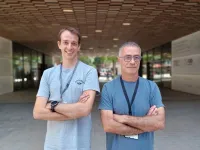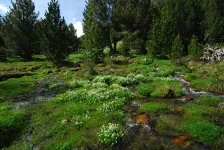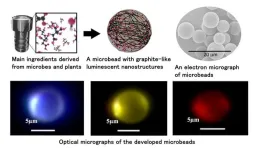(Press-News.org) By Leah Shaffer
You can think of our atmosphere as a big chemistry set, a global churn of gaseous molecules and particles that constantly bounce off and change each other in complicated ways. While the particles are very small, often less than 1% of the thickness of human hair, they have outsized impacts. For example, particles are the seeds of cloud droplets, and the abundance of the particles changes the reflectivity and the amount of clouds, rainfall and climate.
Now, researchers at Washington University in St. Louis have discovered something new in the sky, a mechanism that produces a large portion of particles in Earth’s atmosphere.
The research, published in Science this month was led by Jian Wang, professor and director of the Center for Aerosol Science and Engineering at WashU. The research team includes Lu Xu, assistant professor in WashU’s Department of Energy, Environmental and Chemical Engineering at the McKelvey School of Engineering and scientists from NASA, NOAA, NCA, and European universities.
The conventional thinking was that most particle formation occurs in cloud outflow regions, where clouds float into the upper troposphere and eventually evaporate. In that process, clouds are getting wrung out and most particles are removed by rain. As a result, the air in the outflow regions is clear and clean, leaving some gaseous molecules with nowhere to go but form new particles.
“However, using the data collected from NASA’s global-scale aircraft measurements, we found that most of the new particles are not formed in the outflow regions as previously thought,” Wang said.
While puzzling over this surprising observation, Wang and colleagues ended up discovering a whole different mechanism taking place when the mixing of stratospheric and tropospheric air results in conditions that are ripe for particle formation.
“Stratosphere air often dips in troposphere due to meandering jet stream. As the ozone-rich stratospheric air and more moist tropospheric air mix, it leads to a high concentration of hydroxyl radical (OH), an important oxidant that helps produce the type of molecules that nucleate and form new particles,” said Jiaoshi Zhang, first author on the study and a research scientist in Wang’s lab.
“We found this phenomenon is widespread around the globe and likely occurs more frequently than the particle formation in the cloud outflows,” he added.
Future field observations and modeling studies will be needed to confirm and further quantify the importance of this newly discovered mechanism of particle formation. Obviously, humans contribute their own particles in the form of air pollution, but Wang said what was discovered in this research is a natural process that occurs around the globe, even in remote and pristine regions.
There is also some evidence the stratospheric air will dip into troposphere more frequently in future climate, so this mechanism may become even more important, Wang said. Including this previously unknown process can improve climate models and may help better simulate climate change and predict future climate.
“While we are puzzled by the observation initially, once we put everything together, afterwards it was not so surprising,” Wang said. “It is well known that molecules forming new particles are generated through oxidation in the atmosphere. When the stratosphere and troposphere air mix, the OH concentration is very high, and it’s primed for particle formation.”
Zhang J, Gong X, Crosbie E, Diskin G, Froyd K, Hall S, Kupc A, Moore R, Peischl J, Rollins A, Schwarz J, Shook M, Thompson C, Ullmann K, Williamson C, Wisthaler A, Xu L, Ziemba L, Brock CA, Wang J. Stratospheric Air Intrusions Promote Global-Scale New Particle Formation. Science 385, 210-216 (2024). DOI: https://doi.org/10.1126/science.adn2961
J.W., J.Z., and X.G. were supported by the National Science Foundation (NSF) Division of Atmospheric and Geospace Sciences (grant no. AGS-2147747) and NASA Radiation Sciences Program (grant no. 80NSSC19K0618). K.F., A.K., J.P., A.R., J.S., C.T., C.W., and C.B. were supported by NASA’s Earth System Science Pathfinder Program (grant no. NNH15AB12I) and by NOAA’s Health of the Atmosphere and Atmospheric Chemistry, Carbon Cycle, and Climate (AC4) Programs. K.F., J.P., C.T., and C.W. were also supported in part by NOAA cooperative agreements (grant no. NA17OAR4320101 and NA22OAR4320151). A.K. was supported by the Austrian Science Fund FWF’s Erwin Schrodinger Fellowship (grant no. J-3613). This work was also supported by NASA under awards NNX15AJ23G, NNX15AH33A, NNH13ZDA001N, NNX15AT90G, NNX15AG71A, 80NSSC19K0124, and 80NSSC18K0630.
END
Scientists find new way global air churn makes particles
Researchers at Washington University in St. Louis have discovered a new mechanism by which particles are formed around the globe
2024-07-12
ELSE PRESS RELEASES FROM THIS DATE:
Researchers discover a new neural biomarker for OCD
2024-07-12
A recent study from Baylor College of Medicine and Texas Children’s Hospital has identified a specific neural activity pattern as a novel biomarker to accurately predict and monitor the clinical status of individuals with obsessive-compulsive disorder (OCD) who have undergone deep brain stimulation (DBS), a rapidly emerging therapeutic approach for severe psychiatric disorders. The study, led by led by Drs. Sameer Sheth and Wayne Goodman along with co-lead authors, Drs. Nicole Provenza, ...
Vivid portrait of interacting galaxies marks Webb’s second anniversary
2024-07-12
Two for two! A duo of interacting galaxies commemorates the second science anniversary of NASA’s James Webb Space Telescope, which takes constant observations, including images and highly detailed data known as spectra. Its operations have led to a “parade” of discoveries by astronomers around the world.
“Since President Biden and Vice President Harris unveiled the first image from the James Webb Space Telescope two years ago, Webb has continued to unlock the mysteries of the universe,” said NASA Administrator Bill Nelson. “With remarkable images from the ...
UMass Amherst awarded $2.1 million to advance the science of engagement in community-academic research partnerships
2024-07-12
University of Massachusetts Amherst researcher Thomas Mackie has received a $2.1 million funding award from the Patient-Centered Outcomes Research Institute (PCORI) to advance the meaningful engagement of communities that are affected by mental health disparities and underrepresented in research partnerships.
The study, entitled “Improving Research Partnership With Engagement Mapping: A Pilot Study to Advance Engagement Science” and co-led by Karen Tabb, a University of Illinois Urbana-Champaign researcher, is designed to empower community partners to have a greater role ...
With gene editing, mice with a form of inherited deafness can hear again
2024-07-12
Researchers have used gene editing to restore hearing in adult mice with a type of inherited hearing loss. They showed that shutting down a damaged copy of a gene called a microRNA (miRNA) enabled the animals to regain hearing. The approach by a research team supported by the National Institutes of Health (NIH), reported in Science Translational Medicine, may eventually lead to potential treatments for inherited hearing loss in people.
Zheng-Yi Chen, DPhil., and his colleagues at Mass Eye and Ear in Boston and other institutions studied a rare form of genetic deafness called autosomal dominant deafness-50 (DFNA50). ...
Sant Pau researchers discover a new gene that causes ALS
2024-07-12
Sant Pau researchers discover a new gene that causes ALS
Researchers from the Neuromuscular Diseases Group and the Dementia Neurobiology Group of the Sant Pau Research Institute (IR Sant Pau) and the Memory Unit of the Sant Pau Hospital, led by neurologist Dr. Ricard Rojas-García, have identified a new mutation in the ARPP21 gene that could be the cause of Amyotrophic Lateral Sclerosis (ALS), a devastating neurodegenerative disease.
Specifically, it is a shared mutation (c.1586C>T; p.Pro529Leu) in the ARPP21 gene that ...
Synthetic biology reveals the secrets of life without oxygen
2024-07-12
Long before photosynthesis brought free oxygen into the world, the earth was already populated by numerous organisms. Oxygen was life-threatening for them and therefore they developed completely different metabolic pathways to those we know from plants, animals and humans. Anaerobic bacteria have survived the ages in special, oxygen-free niches, some of them very close to us: as an essential part of the intestinal microbiome, where they are of enormous importance for the well-being of the organism. However, certain anaerobes can ...
UC3M student startup, Solaris Vita, awarded in Europe's largest entrepreneurship competition
2024-07-12
Solaris Vita, a startup created by students at Universidad Carlos III de Madrid (UC3M), has won second place in the "Innovation of the Year" category at Gen-E 2024, the largest European youth entrepreneurship competition, organized by Junior Achievement Europe. This is the first time that a Spanish university team has won this award.
The promoters of Solaris Vita, Miguel Iglesias (Industrial Engineering graduate from UC3M) and Yann Guichard (Economics student at the University), competed ...
How plant cold specialists can adapt to the environment
2024-07-12
Plant cold specialists like the spoonworts have adapted well to the cold climates of the Ice Ages. As cold and warm periods alternated, they developed a number of species that also resulted in a proliferation of the genome. Evolutionary biologists from the universities of Heidelberg, Nottingham, and Prague studied the influence this genome duplication has on the adaptive potential of plants. The results show that polyploids – species with more than two sets of chromosomes – can have an accumulation of structural mutations with signals for a possible local ...
Biomarkers reveal how patients with glaucoma may respond to treatment
2024-07-12
Markers in the blood that predict whether glaucoma patients are at higher risk of continued loss of vision following conventional treatment have been identified by researchers at UCL and Moorfields Eye Hospital.
Over 700,000 people in the UK have glaucoma and it is the leading cause of irreversible blindness worldwide. The condition occurs when the cells in the eye that help you see (called retinal ganglion cells) start to die.
The main risk factors for glaucoma are high eye pressure and older age.
Currently, all licenced treatments are designed to lower pressure in the eye – also known as intraocular pressure. However, some patients ...
Microbeads with adaptable fluorescent colors from visible light to near-infrared
2024-07-12
1. A research team at NIMS has successfully developed an environmentally friendly, microspherical fluorescent material primarily made from citric acid. These microbeads emit various colors of light depending on the illuminating light and the size of the beads, which suggests a wide range of applications. Furthermore, the use of plant-derived materials allows for low-cost and energy-efficient synthesis.
2. Conventional luminescent devices commonly utilized thin films of compound semiconductors containing metals or sintered inorganic materials with rare earth elements. However, in a circular economy, there ...
LAST 30 PRESS RELEASES:
Tracing the quick synthesis of an industrially important catalyst
New software sheds light on cancer’s hidden genetic networks
UT Health San Antonio awarded $3 million in CPRIT grants to bolster cancer research and prevention efforts in South Texas
Third symposium spotlights global challenge of new contaminants in China’s fight against pollution
From straw to soil harmony: International team reveals how biochar supercharges carbon-smart farming
Myeloma: How AI is redrawing the map of cancer care
Manhattan E. Charurat, Ph.D., MHS invested as the Homer and Martha Gudelsky Distinguished Professor in Medicine at the University of Maryland School of Medicine
Insilico Medicine’s Pharma.AI Q4 Winter Launch Recap: Revolutionizing drug discovery with cutting-edge AI innovations, accelerating the path to pharmaceutical superintelligence
Nanoplastics have diet-dependent impacts on digestive system health
Brain neuron death occurs throughout life and increases with age, a natural human protein drug may halt neuron death in Alzheimer’s disease
SPIE and CLP announce the recipients of the 2025 Advanced Photonics Young Innovator Award
Lessons from the Caldor Fire’s Christmas Valley ‘Miracle’
Ant societies rose by trading individual protection for collective power
Research reveals how ancient viral DNA shapes early embryonic development
A molecular gatekeeper that controls protein synthesis
New ‘cloaking device’ concept to shield sensitive tech from magnetic fields
Researchers show impact of mountain building and climate change on alpine biodiversity
Study models the transition from Neanderthals to modern humans in Europe
University of Phoenix College of Doctoral Studies releases white paper on AI-driven skilling to reduce burnout and restore worker autonomy
AIs fail at the game of visual “telephone”
The levers for a sustainable food system
Potential changes in US homelessness by ending federal support for housing first programs
Vulnerability of large language models to prompt injection when providing medical advice
Researchers develop new system for high-energy-density, long-life, multi-electron transfer bromine-based flow batteries
Ending federal support for housing first programs could increase U.S. homelessness by 5% in one year, new JAMA study finds
New research uncovers molecular ‘safety switch’ shielding cancers from immune attack
Bacteria resisting viral infection can still sink carbon to ocean floor
Younger biological age may increase depression risk in older women during COVID-19
Bharat Innovates 2026 National Basecamp Showcases India’s Most Promising Deep-Tech Ventures
Here’s what determines whether your income level rises or falls
[Press-News.org] Scientists find new way global air churn makes particlesResearchers at Washington University in St. Louis have discovered a new mechanism by which particles are formed around the globe





